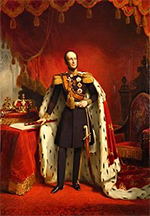King William II of the Netherlands
William II was King of the Netherlands, ruling for nine years in the first half of the 19th Century. 
He was born on Dec. 6, 1792, in The Hague. His father was the Stadhtholder of the House of Orange-Nassau and eventual King William I, and his mother was Princess Wilhelmine of Prussia. When young William was born, his father was fighting in the War of the First Coalition, against France. That conflict went rather badly for the Netherlands, and French troops eventually occupied a significant part of the Dutch Republic. In the wake of the Batavian Revolution, the family fled to Berlin. William spent several years at the Prussian court, getting a military education and then serving in the Prussian Army. He later studied law at Christ Church, at the University of Oxford, in Great Britain. William served in the British Army and, for a time, as an aide-de-camp to Arthur Wellesley, the Duke of Wellington, who was leading Allied efforts in the Peninsular War. William rose through the ranks, achieving the position of major-general by 1813. In that same year, his father returned to the Netherlands, there to assume the role of Sovereign Prince. He accompanied his father, who named his son Prince of Orange. The younger William continued to fight against French armies, sustaining a shoulder injury at the Battle of Waterloo, in 1815. 
Much moreso than his father, William had the support of many people in the Southern Netherlands, what became Belgium. During the uprisings that became the Belgian Revolution, William tried to keep the peace. However, when the southern provinces declared their independence and William I sent in troops to take them back, the younger William accepted his father's commission to lead those troops. The Ten Days' Campaign found little success, and William's troops retreated. The king continued the intended war of reconciliation, but it never achieved its goal. William I bowed to public pressure in 1839 and accepted the terms of the Treaty of 1839, which recognized Belgium as a sovereign nation. William I was the ruler of a Netherlands diminished in geographical terms; he was also much less of an autocratic ruler as a result of a new national constitution. Unable to live within the means of that combination, the king abdicated, on Oct. 7, 1840. His son became King William II. The new monarch acquiesced to popular demands and continued to enjoy the popularity that he had maintained. Despite this popularity, William II found himself the target of the Revolutions of 1848. The Netherlands had yet another constitution, this one even more of a nod to the people's wishes. Unlike other European leaders at the time, William II kept his throne. It wasn't for long, however: He died suddenly on March 17, 1849, in Tilburg. William had married Grand Duchess Anna Pavlovna of Russia, whose older brother was Czar Alexander I, in 1816. They had five children: William (1817), Alexander (1818), Henry (1820), Ernst (1822), and Sophie (1824). When the king died, his oldest son succeeded him, becoming King William III. |
|
Social Studies for Kids
copyright 2002–2026
David White




